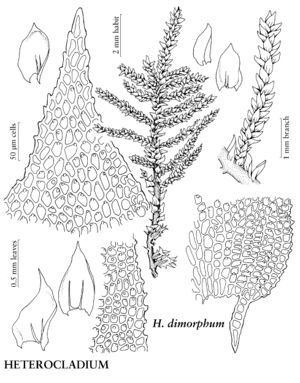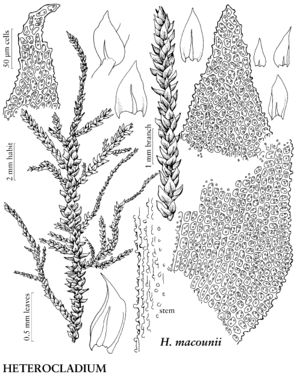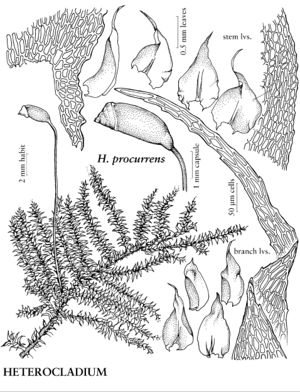Heterocladium
in P. Bruch and W. P. Schimper, Bryol. Europ. 5: 151, plates 479, 480. 1852.
| Taxon | Illustrator ⠉ | |
|---|---|---|
 | Heterocladium dimorphum | Patricia M. Eckel |
 | Heterocladium macounii | Patricia M. Eckel |
 | Heterocladium procurrens | Patricia M. Eckel |
Plants in wiry wefts, dark green to olive green, occasionally yellowish. Stems irregularly branched to pinnate; paraphyllia few or absent. Leaves appressed or squarrose, imbricate, dimorphic, stem-leaves ovate-acuminate, branch leaves ovate; margins plane, serrate, serrulate, or papillose-serrate; apex acute to acuminate; costa single, short, usually 2-fid or double to mid leaf, broad basally; alar cells not differentiated; laminal cells quadrate to rhomboidal, strongly papillose or smooth, walls thickened; basal and juxtacostal cells elongate. Capsule horizontal, short-cylindric, curved.
Distribution
North America, Mexico, Central America (El Salvador), South America, Europe, Asia
Discussion
Species 9 (3 in the flora).
Heterocladium frequently has elongate to flagellate branches. The seta is 0.1–0.2 cm and smooth; the capsule is brown; the operculum is conic-apiculate to short-rostrate; the peristome is perfect, with 2 or 3 elongate, nodose cilia; and the spores are 10–18 µm and essentially smooth.
Selected References
None.
Key
| 1 | Laminal cells smooth; leaves squarrose-spreading when dry. | Heterocladium procurrens |
| 1 | Laminal cells smooth or papillose; leaves spreading to erect-appressed when dry | > 2 |
| 2 | Laminal cell papillae 2-4 per lumen; stem epidermal cells multipapillose; leaf margins papillose-serrate. | Heterocladium macounii |
| 2 | Laminal cell papillae 1 at distal ends; basal cells smooth; stem epidermal cells smooth; leaf margins serrate to serrulate. | Heterocladium dimorphum |